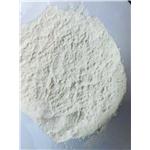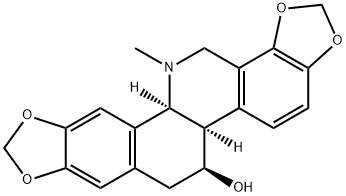- Chelidonine
-

- $0.00 / 20mg
-
2023-02-24
- CAS:476-32-4
- Min. Order: 20mg
- Purity: ≥98%(HPLC)
- Supply Ability: 10 g
- chelidonine
-

- $90.00 / 1kg
-
2023-02-13
- CAS:476-32-4
- Min. Order: 1kg
- Purity: 99%
- Supply Ability: 100MT
- Chelidonine 476-32-4
-

- $88.00 / 20mg
-
2022-02-14
- CAS:476-32-4
- Min. Order: 20mg
- Purity: ≥98%
- Supply Ability: 1000.00 kgs
|
| Product Name: | CHELIDONINE | | Synonyms: | chelidoniny;helidonine;khelidonin;STYLOPHORIN;STYLOPHORINE;STYLOPHORON;CHELIDONIN;(+)-CHELIDONINE | | CAS: | 476-32-4 | | MF: | C20H19NO5 | | MW: | 353.37 | | EINECS: | 207-504-1 | | Product Categories: | Alkaloids | | Mol File: | 476-32-4.mol |  |
| | CHELIDONINE Chemical Properties |
| Melting point | 135-140°C | | alpha | D22 +115 ±3° (ethanol); D20 +117° (c = 3 in CHCl3) | | Boiling point | bp0.002 220° (air-bath temp) | | density | 1.2976 (rough estimate) | | refractive index | 1.5800 (estimate) | | storage temp. | Sealed in dry,2-8°C | | solubility | Soluble in chloroform; slightly soluble in methan | | form | powder | | pka | 14.11±0.20(Predicted) | | color | Colorless | | Merck | 13,2061 | | InChIKey | GHKISGDRQRSCII-ZOCIIQOWSA-N | | LogP | 2.899 (est) | | CAS DataBase Reference | 476-32-4(CAS DataBase Reference) |
| Hazard Codes | Xn | | Risk Statements | 25-20/21/22 | | Safety Statements | 20-45-36/37 | | RIDADR | 2811 | | WGK Germany | 3 | | RTECS | FL9450000 | | Toxicity | LD50 in mice (mg/kg): 34.6 ±2.44 i.v. (Anderson, Chen) |
| | CHELIDONINE Usage And Synthesis |
| Description | Chelidonine, also named ranunculine, is a benzophenanthridine alkaloid isolated from the whole plant of Chelidonium majus. L. It has been used as a painkiller in clinical treatment based on its morphine-like analgesic effect. Pharmacological researches in recent years have demonstrated that chelidonine played a role in antitumor, antibacterial, spasmolysis activities, and so on. And the antitumor activity is drawing more and more attention. However, its mechanisms of function remain unclear, which needs to be clarified in the future.
Chelidonine is an alkaloid fundamental parent, a benzophenanthridine alkaloid and an alkaloid antibiotic. Chelidonine is an isolate of Papaveraceae with acetylcholinesterase and butyrylcholinesterase inhibitory activity .
| | Uses | Chelidonine is the major alkaloid component of Chelidonium majus. Chelidonium majus L. is the only species of the tribe Chelidonieae of the Papaveraceae family. The Papaveraceae family is rich in specific alkaloids. C. majus contains various isoquinoline alkaloids with protopine, protoberberine and benzophenanthridine structures. This benzophenanthridine alkaloid can induce apoptosis in some transformed or malignant cell lines. D-Chelidonine, the main alkaloid of Chelidonium majus, was first isolated in 1839.
Chelidonine is a major bioactive, isoquinoline alkaloid ingredient in Chelidonium majus. Benzylisoquinoline alkaloids (BIAs) are a structurally diverse group of plant specialized metabolites with a long history of investigation. A restricted number of enzyme families have been implicated in BIA metabolism. Whereas some enzymes exhibit a relatively broad substrate range, others are highly substrate specific. A small number of plant species, including opium poppy (Papaver somniferum) and other members of the Ranunculales, have emerged as model systems to study BIA metabolism. Recently, the emergence of transcriptomics, proteomics and metabolomics has expedited the discovery of new BIA biosynthetic genes.
| | Pharmacological action | Chelidonine is an isolate of Papaveraceae with acetylcholinesterase and butyrylcholinesterase (a nonspecific cholinesterase) inhibitory activity. AChE (acetylcholinesterase) inhibitors or anti-cholinesterases inhibit the cholinesterase enzyme from breaking down ACh, increasing both the level and duration of the neurotransmitter action. According to the mode of action, AChE inhibitors can be divided into two groups: irreversible and reversible. Reversible inhibitors, competitive or noncompetitive, mostly have therapeutic applications, while toxic effects are associated with irreversible AChE activity modulators. Reversible AChE inhibitors play an important role in pharmacological manipulation of the enzyme activity. These inhibitors include compounds with different functional groups (carbamate, quaternary or tertiary ammonium group), and have been applied in the diagnostic and/or treatment of various diseases such as: myasthenia gravis, AD, post-operative ileus, bladder distention, glaucoma, as well as antidote to anticholinergic overdose. In general, methyltransferases of BIA metabolism accept a wide variety of alkaloid substrates with diverse backbone structures, with some showing more flexibility than others with respect to substrate range.
| | Description | Chelidonine, also named ranunculine, is a kind of alkaloid isolated from the whole
plant of Chelidonium majus. L . As a kind of traditional Chinese medicine,
Chelidonium majus. L was firstly recorded in Chiu Huang Pen Ts’ao of Ming
dynasty. In the seventeenth century, it has been used for the treatment of jaundice,
biliary colic, and cholelithiasis. In 1941, a researcher from Soviet Union reported
that it showed good effect for the treatment of cutaneous tuberculosis. This plant has
multiple effects on different diseases, including anti-inflammatory, analgesia,
relieving cough, inducing diuresis, anticancer, antifungal, relieving asthma, and
detoxification. It was recorded in the Pharmacopoeia of the People’s Republic of
China (1977) .
The material basis for Chelidonium majus. L is alkaloid. Among which, chelidonine,
a benzophenanthridine alkaloid, is the main effective ingredient . Although
great progresses have been made in the chemical synthesis of chelidonine recently,
the biosynthetic pathways of chelidonine remain unclear, which still need in-depth
study and exploration in the future | | Description | Chelidonine is a benzophenanthridine alkaloid that has been isolated from C. majus. It induces Bcl-2- and caspase-dependent apoptosis in HepG2 human liver carcinoma cells with an LC50 value of 12 μM and in Jurkat human T cells when used at a concentration of 1 μM. Chelidonine also downregulates hTERT expression in HepG2 cells, reduces telomerase activity, and induces cell senescence. | | Chemical Properties | White, crystalline powder alkaloid. | | Physical properties | Appearance: white crystal or crystalline powder, monoclinic prism crystal.
Solubility: insoluble in water; soluble in ethanol, chloroform, and amyl alcohol.
Melting point: 135–136 °C. Boiling point: 220 °C. Specific optical rotation: +115°. | | History | Chelidonine was isolated from Chelidonium majus. L in 1824 for the first time.
Pharmacological studies found that it exerted antitumor effect via different mechanisms.
However, its poor bioavailability limited its application. Some researchers developed a chelidonine/polylactic acid copolymer nanoparticle using nanotechnology.
The nano-chelidonine showed good tissue distribution without causing any
toxicity in mice and could enter into the brain tissues, showing great application
potential. In addition, nano-chelidonine showed protective effect on liver injury
induced by cadmium in mice .
In 1981, an Austrian researcher isolated a novel compound ukrain (phosphorothioate
derivative of chelidonine) from Chelidonium majus. L. Ukrain could inhibit
tumor cell proliferation through a variety of mechanisms. Currently, ukrain is used
as an antitumor drug for the clinical treatment of lung cancer, breast cancer, prostate
cancer, and pancreatic cancer . In 2004, quarter amine chelidonine phosphorothioate
derivatives have been applied for an invention patent as anticancer drugs in
China.
Chelidonine has morphine-like analgesic effects suggesting that its analgesic
effect is mainly peripheral and cannot be antagonized by the morphine receptor
antagonist naloxone . The 6-alkoxy and 6-acyloxy derivatives of chelidonine can
inhibit the central nervous system, especially for nerve terminal, and show sedative
and hypnotic effects . | | Uses | Poison; central nervous system depres-
sant causing sleepiness, depression, slowing of the
pulse, coma and circulatory failure. | | Definition | ChEBI: Chelidonine is an alkaloid fundamental parent, a benzophenanthridine alkaloid and an alkaloid antibiotic. | | Biochem/physiol Actions | Inhibits tubulin polymerisation (IC50=24 μM), thereby disrupting microtubule structure in cells and inducing a G2/M mitotic arrest. | | Pharmacology | Chelidonine has a variety of pharmacological effects, mainly manifested in the following
aspects:
1. The effect on nervous system (analgesia, sedation)
Chelidonine, as a protopine, has analgesia effect similar to that of morphine.
After intragastric administration (5–20 mg/kg) to mice, it showed a dose-dependent
analgesic effect, which could sustain 4–48 h . Chelidonine derivatives also have
sedative and hypnotic effects .
2. The effect on cardiovascular systemChelidonine has many effects on cardiovascular system, including exciting heart,
expanding coronary blood vessels, and increasing blood pressure. Chelidonine
(0.01–0.02 mg) leads to the excitement of frog heart in vitro, as well as slowdown
of heart beat. Higher dosage (0.05 mg) of chelidonine could cause arrhythmia and
diastolic cardiac arrest .
3. The antitumor effect
Chelidonine is a toxic substance that can influence mitosis. In vitro studies have
shown that chelidonine had significant inhibitory effects for gastric cancer, leukemia,
nasopharyngeal carcinoma, and hepatoma carcinoma cells. It also could delay
the growth of malignant tumors. Its antitumor effects were mediated by different
mechanisms, which still need further studies .
4. The effect on smooth muscle
Chelidonine has spasmolytic and diastolic effects and can inhibit a variety of
smooth muscle spasm. Obvious spasmolytic effects for gastrointestinal tract and
bronchial and urinary system have been reported .
5. The antibacterial effect
Chelidonine has antibacterial effect. It inhibits Mycobacterium tuberculosis
in vivo and inhibits alpha Streptococcus, Diplococcus pneumoniae, and other gram-positive
bacteria in vitro. In addition, chelidonine also shows inhibitory effect on
Kauffman-Wolf Trichophyta and Epidermophyton floccosum .
6. Other pharmacological effects
Chelidonine showed protective effects on cadmium chloride-induced liver and
kidney toxicity in rats. Chelidonine can inhibit the growth of human keratinocytes.
Guinea pig test confirmed that chelidonine (4–10 mg/kg) could prevent or delay the
anaphylactic shock. In addition, chelidonine has anti-mite effect and good synergistic
effect with trichlorfon or omethoate to prevent cotton bollworm. | | Clinical Use | Chelidonine has been used as a painkiller in clinical application due to its significant
analgesic effect. Chelidonine phosphate can be used for treatment of gastrointestinal
and ulcer pain, as a substitute of morphine preparations. Wei Tong Shu capsule
is used to treat pain caused by gastric convulsion, chronic gastritis, gastric ulcer, and
duodenal ulcer. Its main effective compositions are chelidonine and protopine. Fu
Fang Zhong Yao Tong An injection has collateral dredging and analgesic effects and
can be used for the treatment of moderate pain caused by chemoradiotherapy or
non-chemoradiotherapy of gastric cancer, lung cancer, and liver cancer. Its two
main components are chelidonine and sinomenine. Ukrain (NSC-631570), a phosphorothioate
derivative of chelidonine, has been used in clinical treatment as an
effective antitumor drug for the treatment of lung cancer, breast cancer, prostate
cancer, and pancreatic cancer. |
| | CHELIDONINE Preparation Products And Raw materials |
|